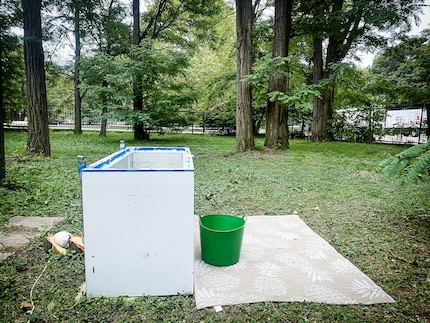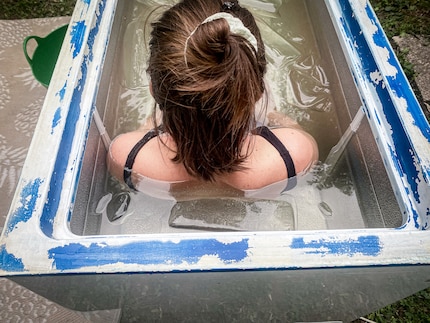
Background information
We love to lüft: the very German and Swiss art of airing a room
by Katherine Martin

They run into the sea wearing woolly hats or voluntarily lie down in bathtubs filled with ice cubes: Ice swimmers. Can I do that too? In a freezer in the park, of all places, I discover my love for the cold and ice bathing.
I'm shivering in a swimming costume in a Viennese park at twelve degrees Celsius. In front of me is a discarded freezer. Every single hair on my body has stood up, expecting the worst. I take a brave step towards the freezer, inhale and go. A thousand tiny knife wounds.
My ice bath lasts just two minutes. But before I go into more detail, I need to explain why I am in this bizarre scene in the park.
Whoever commits to ice bathing usually raves about it. Never sick again, fitter than ever, no more sore muscles. Marcus Bernhardt is also a fan. He discovered his passion for ice baths after a week of Wim Hof training in Poland. Without further ado, he decides to offer cold weather training in Vienna himself and to continue the tradition of the Dutch "Iceman".
Wim Hof once said, "What I'm capable of, anyone can learn." I took him at his word and that's why the lonely freezer and I now have a date. The mood is, it can't be helped: frosty.
For my preparation, all I need is the will to take a cold shower. Besides breathing and exposure to cold, I now also understand what Wim Hof means by the third pillar, "willpower". This is actually already the first lesson, because: Cold resistance starts in the head.
Besides me, Achmed is also there. He comes every week for ice bathing, all winter long. Without batting an eyelid, he strips down to his swimming trunks and climbs into the freezer while I frantically try to catch up on missed breathing exercises. Achmed makes it look so easy that I quickly collect myself and regain confidence in my body and, more importantly, in my head.
I'm on it. Bernhardt very calmly tells me what to do: take one deep breath and then, with the exhale, step into the water in a slow movement up to above my shoulders. To keep the tub clean, I first get into the small bucket in front of the ice bath and use it to wash the grass off my feet. I breathe in and climb into the deep freeze. Two minutes. The clock is running.
I can't remember the first milliseconds in the ice water. They are as if they have been erased. Afterwards, however, it is as Bernhardt had said: my senses are heightened, my thoughts crystal clear, while my body burns and a heavy sandbag tightens around my chest. Like the thousand little pinpricks, the adrenaline also shoots through my body with such force that I can still write down my thoughts days later. Even the less eloquent ones. Here is an excerpt:
The study, however, shows that the body's immune system is not affected by cold water.
Winter swimming is also popular in Switzerland: what took off as a lockdown trend successfully persists to this day. You don't like to plunge into the ice-cold water alone, but prefer to do it under supervision? Here's a selection for winter bathers:
I'm a sucker for flowery turns of phrase and allegorical language. Clever metaphors are my Kryptonite – even if, sometimes, it's better to just get to the point. Everything I write is edited by my cat, which I reckon is more «pet humanisation» than metaphor. When I'm not at my desk, I enjoy going hiking, taking part in fireside jamming sessions, dragging my exhausted body out to do some sport and hitting the occasional party.
Interesting facts about products, behind-the-scenes looks at manufacturers and deep-dives on interesting people.
Show all
Background information
by Katherine Martin

Background information
by Michael Restin

Background information
by Cassie Mammone
My brain is just flinging as much dopamine into my blood as if I were doing coke. At least that's what my Wim Hof coach Marcus Bernhardt tells me, talking me down from the bottom of the freezer. He accompanies me through my outdoor ice bath on this chilly Saturday evening. Emblazoned on his T-shirt in blue lettering is: "Strength is a decision", the motto of his cold workshops in the Vienna Prater. He not only fills freezers with ice water, but also offers breathing courses and mental training. His courses are thus in the tradition of the famous extreme athlete Wim Hof, who became world-famous as the "Iceman". The Dutchman is a master of extreme cold and has enjoyed beating his own world records in the process: most recently in 2011 with a 112-minute ice bath. The current holder of the title for the longest ice bath is the Austrian extreme athlete Josef Köberl, but Wim Hof has a different goal in the meantime: On his YouTube channel, he declared in 2019 in a Q&A, that proving his method scientifically was more important to him than breaking the next world record.
I am easily impressed by extreme athletes. It fascinates me what our bodies can do when they are not in resting positions for 23 hours and 40 minutes a day. People like the Nepalese mountaineer Lhakpa Gelu Sherpa, who climbed to the top of Mount Everest in less than eleven hours: to prepare, he walked 20 kilometres up a mountain every morning with a heavy backpack. People like him bend and break the limits of the body in every conceivable direction and, not least, show steely nerves and an iron will.
And speaking of Mount Everest: "Iceman" Wim Hof has not passed me by without leaving a trace either. The fact that he conquered the world's highest mountain in 2007 wearing only shorts and sandals (and thus mocked it) made a big impression on me. Wim Hof is the figurehead of his own health movement. For him, the cold is a mental trainer, regeneration aid and immune boost all in one. Explained very briefly, the Wim Hof method is about cold exposure combined with a certain breathing technique. The two together are said to strengthen body and mind.
"You have an incredible learning opportunity in the water. You put yourself in a panic situation, similar to a car accident. What you experience in the ice bath burns itself into your brain," my coach Bernhardt tells me in advance. And that's why I start at home with a series of alternating baths. I hope this will provide me with a kind of mental airbag to cushion my impact. Theoretically, it works like this: first you shower off your feet and hands with cool water and then slowly move the shower head towards the centre of your body.
The first day I stand rooted to the spot in the shower. I can barely get over my knees and feel so sorry for myself that I break off. On the second day I try it differently: I start with my hands and slowly feel my way up to my shoulders. Once there, I hope that gravity will distribute the water over the rest of my body. When the first drops run down my back, I almost slip out of shock and postpone the cold shower again. On the third and fourth day, I get on my own nerves so much that - contrary to every recommendation - I start in the middle of my body and thus end the discussion with myself. On the fifth day I run myself a bubble bath. Well, Rome wasn't built in a day.
The second lesson I could have taken away at this point and will live to regret not doing so: Proper breathing makes a huge difference. In short, it's about mentally preparing yourself for the ice bath in a breathing meditation. Wim Hof suggests a breathing technique in which we basically hyperventilate: Rapid, deep inhalations and exhalations alternate with a few seconds of holding one's breath. As a result, the oxygen level in the blood rises and our body goes into a heightened state of performance. This is shown by a study, which attributes this effect to the stronger influence of the sympathetic nervous system - the part of the autonomic nervous system that is activated in stress and emergency situations.
So the body is exposed to an artificial stress situation. Adrenalin is released and the blood vessels contract. This is how my coach Marcus Bernhardt explains it to me: "Breathing causes the adrenaline to go through the roof and the body becomes less sensitive to pain". In the ice bath, you experience an exceptional situation: Through breathing and exposure to cold, we confront the body with stress in a controlled setting, which trains our resistance and how to deal with panic situations. Mental training in which you are literally thrown in at the deep end.
It's Saturday and time for my ice bath. It's chilly outside, it's drizzling and I've got my period. A not insignificant piece of information for all readers who are thinking about an ice bath: there are definitely better times for it. For those who haven't read it between the lines yet: No, I don't like the cold. It takes a lot of effort for me to even leave the flat in this weather. So the mental training actually starts at my doorstep. When I arrive in Vienna's Prater, I first go on a roller coaster ride in the amusement park. This is my personal method of getting my pulse, adrenaline and body temperature up for the ice bath ahead. Next lesson: Riding a roller coaster is no substitute for breathing meditation.

This is what Marcus Bernhardt has been leading in the group workshop all day today, before I drop by his place for an ice bath at 6pm. He tells me about his breathing workshop, the crowning glory of which is often, but not always, the ice bath. This is emblematic of challenges we face in life: "If you can move out of your comfort zone with difficult life issues, you can handle the water." At the end of the ice bath, you can feel in your own body how much you can actually take. The feedback from the body confirms the mental feat you have just successfully accomplished: "You can take that with you for your life," says Bernhardt. I'd rather take a hot tea with me now.
He leads me outside to a meadow and around the corner behind a shed. And there it is, the freezer. When I see it, I wince. Apparently I have successfully repressed up to this point that it is about to get very, very cold. The coach opens the chest and reveals the full extent of my megalomaniac idea to follow the example of the "ice cream man". There are large blocks of ice floating in the chest and a small thermometer that reads 3°C. I pull myself back into my thick jacket up to both ears.

It is for Achmed. He sits down in the ice bath again right after me and this time even stays in it for about three minutes. For me, that's not an option at first: my whole body is burning and bright red. Nevertheless, I can't stop grinning. I can 100 per cent endorse the feelings of happiness after the ice bath. Not the fact that you're supposedly glowing with warmth afterwards. Actually, I rather have the feeling of having lost my remaining body heat deep down in the freezer.
Despite this, I feel very good overall. Why this is so has not been definitively explained, even in science. Studies suggest: "Regular swimming training in cold water seems to have a positive effect on various systems such as the cardiovascular system, the hormonal and immune system as well as the psyche". The results also suggest that: Winter swimmers suffer from respiratory diseases relatively less often compared to non-winter swimmers. After a 150-metre swim in water that is six degrees Celsius cold, an increase in leukocytes, the white blood cells, was measured. And their main task is to defend against pathogens. According to the study, a few minutes in cold water causes a strong immune reaction in the body, similar to that of a pathogen.
But the study also points out the risks: Because the cold is an absolutely exceptional situation for the cardiovascular system, cardiac arrhythmias or cardiac arrest can occur in individual cases. I, too, had a heavy sandbag placed on my chest and my air was cut off for a moment. Even if many studies are gathering around ice bathing, promising fitness and mental health, critical voices are always being raised. Scientists even disagree about whether breathing exercises per se have a direct, positive effect on health. The team at Medicine Transparent, for example, has reviewed all the studies on Wim Hof & Co and describes them as flawed. Their conclusion: "There is no evidence for any of these promises."
Whether provable biochemical processes in the brain or fairy dust from Wim Hof himself: I feel pretty good after my ice bath. Maybe it's also because of Marcus Bernhardt's motivating words. Or because I was surprised at myself for having survived this ice bath. Or because I'm just glad to have it behind me ... What the cold water gave me: At least for two minutes I could feel strong like an extreme athlete. Whether it's worth it to me to get into the deep freeze regularly, I don't know yet.